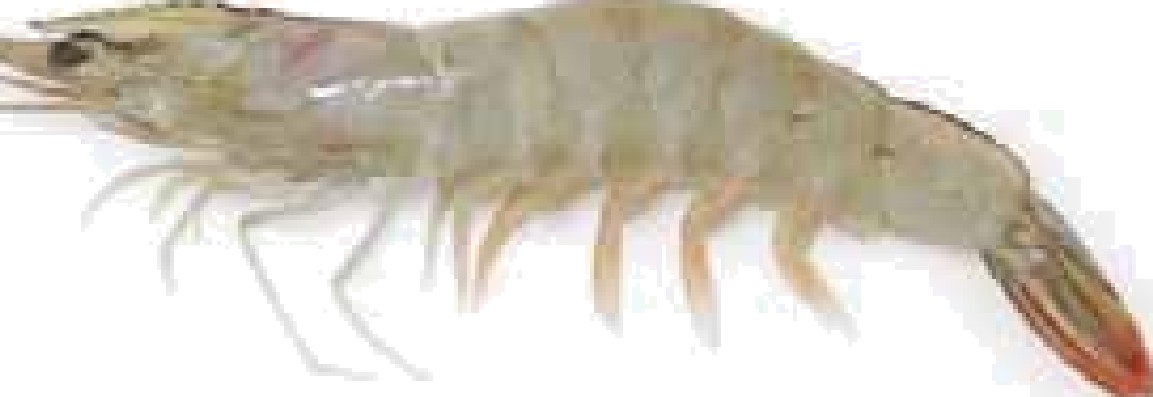Production of Indian White Shrimp
Production of Indian White Shrimp
 The Indian white shrimp, Penaeus indicus a native of India and South East Asia, is one of the suitable species for brackish water aquaculture.
The Indian white shrimp, Penaeus indicus a native of India and South East Asia, is one of the suitable species for brackish water aquaculture.
In natural conditions, the adult is seen up to 90 m depth over muddy or sandy sea bottom while the post-larva and juvenile inhabit shallow estuarine waters.
It fetches good price in local markets even at small sizes. The exoskeleton is relatively thin, which provides more edible meat per unit total weight of the shrimp.
Seed Production
Seed production of Indian white shrimp is similar to that of the tiger shrimp with slight variations in the rearing techniques and feeding patterns. The major advantage is that the gravid female in the required size is locally available in all seasons.
Procurement of broodstock
The gravid female in the size range of 30-50 g is selected and kept for spawning in an FRP tank with clear seawater and mild aeration.
Water quality management
It is same as that explained for the milkfish.
Maturation
The process is similar to that explained for the tiger shrimp.
Mating
It is similar to that explained for the tiger shrimp.
Spawning
Spawning takes place in the night. The female may feed on spawned eggs; hence a mesh tray is installed on the bottom of the spawning tank or the eggs are taken-out during early morning using scoop net. The eggs are kept for hatching and metabolic wastes from the tank are siphoned out. Fecundity is usually 0.5-1 lakh per individual, which varies according to the size of the female. Other aspects are similar to that explained for the tiger shrimp.
Incubation
It is almost similar to that explained for the tiger shrimp. The eggs are incubated at a density of 4000 no./l in hatching tank of 0.3-1 t capacity at a temperature of 28-32° C and salinity of 28-35 ppt. The hatching takes place in 12-15 hours. The hatching rate is usually more than 70%. The egg hatches out into nauplius, a non-feeding stage and takes almost 36-40 hours for moulting and becomes protozoea.
Rearing of larvae
There are 3 protozoeal stages, which may take almost 4 days (PZ1- 36 hr, PZ2-24 hr and PZ3-36 hr) to metamorphose into the next stage called mysis. The mysis has 3 stages which take another 4 days (Ml- 36 hr, M2-24 hr, M3-36 hr). The larvae (protozoea and mysis stages) are stocked at a density of 100-150/1 and are fed with live diatoms like Chaetoceros and Skeletonema @ 80,000 cells/ml of water in the tank. The other aspects are similar to that explained for the tiger shrimp. The mysis moults into the post-larva.
Rearing of Post-Larvae (PL)
The stocking density of PL in tank is 100 /l. The PU to PL 7 is fed with live Artemia nauplii and PL8 to PL15 with an artificial larval diet. It can also be fed with squilla meat, taking care of the water quality by removing the waste periodically. Well performing PL diets are also available in plenty in the market. The other aspects of PL rearing are similar to that of the tiger shrimp. The easy availability of spawners makes Indian white shrimp a desirable species among hatchery operators even now. At the same time the demand for the seed is far less compared to tiger shrimp and so the seed price is too low.
Monitoring
It is same as that explained for the tiger shrimp.
Harvest and transportation
The seed is harvested and transported at PLl2 to PL15 stage which takes 22-25 days from hatching. Other aspects are same as that explained for the tiger shrimp.
Pond Farming
Site selection & pond construction
The aspects of site selection and pond construction are similar to that explained for the tiger shrimp.
Preparation of pond
Pond preparation steps like draining, drying, liming, eradication of unwanted organisms and manuring are followed more or less in a similar way as prescribed for the tiger shrimp.
Water quality requirements
The suitable range of water quality parameters considered to be optimum are given below:
Temperature : 26-32ºC
pH : 7.5-8.5
Transparency : 25-45 cm
Salinity : 25-35 ppt
DO : >4 ppm
Alkalinity : ~200 ppm
TAN : <0.1ppm
NO2-N : <0.1 ppm
NO3-N : <10 ppm
H2S : <0.1 ppm
Iron : <1 ppm
Hardness: 50-150 ppm
Stocking
The PCR screened seed (PL-12) is stocked after acclimatisation at a density of 10/m2. Since Indian white shrimp prefers high salinity regimes (20-25 ppt) than tiger shrimp, its culture is normally scheduled during the summer months in Kerala. Stocking is scheduled during mid- January, so that the culture period can be extended up to the end of April. In the coastal area where tidal effect is used for farming, the rules and regulations of Coastal Aquaculture Authority, Chennai need to be strictly adhered to.
Feeding
The Indian white shrimp is fed four times daily with a sinking pelletted feed having 30-35% protein. Other aspects of feeding are similar to that of the tiger shrimp.
Care and monitoring
Water quality parameters should be checked and managed as in the case of the tiger shrimp.
Harvesting
The Indian white shrimp attain 20-25 g size within 90-110 days. Harvesting is done as explained for the tiger shrimp. Production of 1.6-2 t/ha can be realized with a survival rate of 80%. Even though duration of farming of the Indian white shrimp is less than 4 months, only one crop is generally taken in a year to ensure high salinity and environmental sustainability. For the rest of the year, the same pond can be used for paddy cultivation.
Last Modified : 12/28/2022
ICAR-Central Institute of Fisheries Technology COV...
This topic provides information about Trout Cultur...
This topic provides information about Marine Fin F...
This topic provides information about Trout Cultur...
